Ultrasound guidance for arterial (other than femoral) catheterisation in adults
- PMID: 34637140
- PMCID: PMC8507521
- DOI: 10.1002/14651858.CD013585.pub2
Ultrasound guidance for arterial (other than femoral) catheterisation in adults
Abstract
Background: Arterial vascular access is a frequently performed procedure, with a high possibility for adverse events (e.g. pneumothorax, haemothorax, haematoma, amputation, death), and additional techniques such as ultrasound may be useful for improving outcomes. However, ultrasound guidance for arterial access in adults is still under debate.
Objectives: To assess the effects of ultrasound guidance for arterial (other than femoral) catheterisation in adults.
Search methods: We searched CENTRAL, MEDLINE, Embase, LILACS, and CINAHL on 21 May 2021. We also searched IBECS, WHO ICTRP, and ClinicalTrials.gov on 16 June 2021, and we checked the reference lists of retrieved articles.
Selection criteria: Randomised controlled trials (RCTs), including cross-over trials and cluster-RCTs, comparing ultrasound guidance, alone or associated with other forms of guidance, versus other interventions or palpation and landmarks for arterial (other than femoral) guidance in adults.
Data collection and analysis: Two review authors independently performed study selection, extracted data, assessed risk of bias, and assessed the certainty of evidence using GRADE.
Main results: We included 48 studies (7997 participants) that tested palpation and landmarks, Doppler auditory ultrasound assistance (DUA), direct ultrasound guidance with B-mode, or any other modified ultrasound technique for arterial (axillary, dorsalis pedis, and radial) catheterisation in adults. Radial artery Real-time B-mode ultrasound versus palpation and landmarks Real-time B-mode ultrasound guidance may improve first attempt success rate (risk ratio (RR) 1.44, 95% confidence interval (CI) 1.29 to 1.61; 4708 participants, 27 studies; low-certainty evidence) and overall success rate (RR 1.11, 95% CI 1.06 to 1.16; 4955 participants, 28 studies; low-certainty evidence), and may decrease time needed for a successful procedure (mean difference (MD) -0.33 minutes, 95% CI -0.54 to -0.13; 4902 participants, 26 studies; low-certainty evidence) up to one hour compared to palpation and landmarks. Real-time B-mode ultrasound guidance probably decreases major haematomas (RR 0.35, 95% CI 0.23 to 0.56; 2504 participants, 16 studies; moderate-certainty evidence). It is uncertain whether real-time B-mode ultrasound guidance has any effect on pseudoaneurysm, pain, and quality of life (QoL) compared to palpation and landmarks (very low-certainty evidence). Real-time B-mode ultrasound versus DUA One study (493 participants) showed that real-time B-mode ultrasound guidance probably improves first attempt success rate (RR 1.35, 95% CI 1.11 to 1.64; moderate-certainty evidence) and time needed for a successful procedure (MD -1.57 minutes, 95% CI -1.78 to -1.36; moderate-certainty evidence) up to 72 hours compared to DUA. Real-time B-mode ultrasound guidance may improve overall success rate (RR 1.13, 95% CI 0.99 to 1.29; low-certainty evidence) up to 72 hours compared to DUA. Pseudoaneurysm, major haematomas, pain, and QoL were not reported. Real-time B-mode ultrasound versus modified real-time B-mode ultrasound Real-time B-mode ultrasound guidance may decrease first attempt success rate (RR 0.68, 95% CI 0.55 to 0.84; 153 participants, 2 studies; low-certainty evidence), may decrease overall success rate (RR 0.93, 95% CI 0.86 to 1.01; 153 participants, 2 studies; low-certainty evidence), and may lead to no difference in time needed for a successful procedure (MD 0.04 minutes, 95% CI -0.01 to 0.09; 153 participants, 2 studies; low-certainty evidence) up to one hour compared to modified real-time B-mode ultrasound guidance. It is uncertain whether real-time B-mode ultrasound guidance has any effect on major haematomas compared to modified real-time B-mode ultrasound (very low-certainty evidence). Pseudoaneurysm, pain, and QoL were not reported. In-plane versus out-of-plane B-mode ultrasound In-plane real-time B-mode ultrasound guidance may lead to no difference in overall success rate (RR 1.00, 95% CI 0.96 to 1.05; 1051 participants, 8 studies; low-certainty evidence) and in time needed for a successful procedure (MD -0.06 minutes, 95% CI -0.16 to 0.05; 1134 participants, 9 studies; low-certainty evidence) compared to out-of-plane B-mode ultrasound up to one hour. It is uncertain whether in-plane real-time B-mode ultrasound guidance has any effect on first attempt success rate or major haematomas compared to out-of-plane B-mode ultrasound (very low-certainty evidence). Pseudoaneurysm, pain, and QoL were not reported. DUA versus palpation and landmarks DUA may lead to no difference in first attempt success rate (RR 1.01, 95% CI 0.90 to 1.14; 666 participants, 2 studies; low-certainty evidence) or overall success rate (RR 0.99, 95% CI 0.92 to 1.07; 666 participants, 2 studies; low-certainty evidence) and probably increases time needed for a successful procedure (MD 0.45 minutes, 95% CI 0.20 to 0.70; 500 participants, 1 study; moderate-certainty evidence) up to 72 hours compared to palpation and landmarks. Pseudoaneurysm, major haematomas, pain, and QoL were not reported. Oblique-axis versus long-axis in-plane B-mode ultrasound Oblique-axis in-plane B-mode ultrasound guidance may increase overall success rate (RR 1.27, 95% CI 1.05 to 1.53; 215 participants, 2 studies; low-certainty evidence) up to 72 hours compared to long-axis in-plane B-mode ultrasound. It is uncertain whether oblique-axis in-plane B-mode ultrasound guidance has any effect on first attempt success rate, time needed for a successful procedure, and major haematomas compared to long-axis in-plane B-mode ultrasound. Pseudoaneurysm, pain, and QoL were not reported. We are uncertain about effects in the following comparisons due to very low-certainty evidence and unreported outcomes: real-time B-mode ultrasound versus palpation and landmarks (axillary and dorsalis pedis arteries), real-time B-mode ultrasound versus near-infrared laser (radial artery), and dynamic versus static out-of-plane B-mode ultrasound (radial artery).
Authors' conclusions: Real-time B-mode ultrasound guidance may improve first attempt success rate, overall success rate, and time needed for a successful procedure for radial artery catheterisation compared to palpation, or DUA. In addition, real-time B-mode ultrasound guidance probably decreases major haematomas compared to palpation. However, we are uncertain about the evidence on major haematomas and pain for other comparisons due to very low-certainty evidence and unreported outcomes. We are also uncertain about the effects on pseudoaneurysm and QoL for axillary and dorsalis pedis arteries catheterisation. Given that first attempt success rate and pseudoaneurysm are the most relevant outcomes for people who underwent arterial catheterisation, future studies must measure both. Future trials must be large enough to detect effects, use validated scales, and report longer-term follow-up.
Trial registration: ClinicalTrials.gov NCT02550223 NCT03656978 NCT02825615 NCT01789801 NCT01660724 NCT03405623 NCT01663779 NCT02118441 NCT01605292 NCT03537118 NCT04001764 NCT04077762 NCT01189188 NCT02584673 NCT03144895 NCT03995264 NCT04318990.
Copyright © 2021 The Cochrane Collaboration. Published by John Wiley & Sons, Ltd.
Conflict of interest statement
RLGF: none known.
VFMT: none known.
RDL: declares grants from Bristol‐Myers Squibb, GlaxoSmithKline, Medtronic, Pfizer, and Sanofi via institution and consulting fees from Bayer, Boehringer Ingleheim, Bristol‐Myers Squibb, Daiichi Sankyo, GlaxoSmithKline, Medtronic, Merck, Pfizer, Portola, and Sanofi.
JCCBS: none known.
CDQF: none known.
LCUN: none known.
Figures

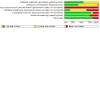


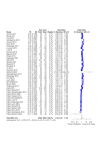








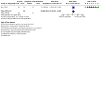

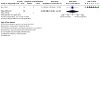


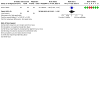


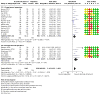
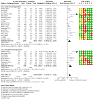

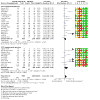

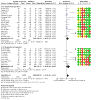

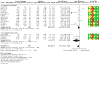
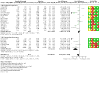
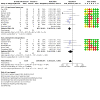





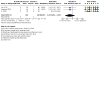
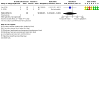

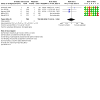






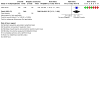




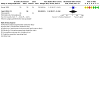

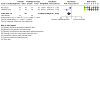
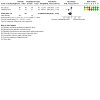

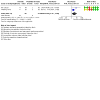
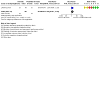

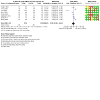



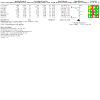

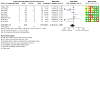

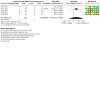
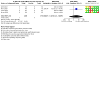

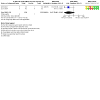

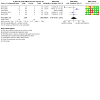





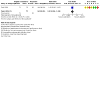








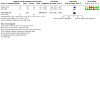

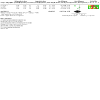




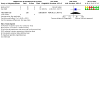
Update of
References
References to studies included in this review
Abdalla 2017 {published data only (unpublished sought but not used)}
-
- NCT02550223. Ultrasound Guided Radial Artery Cathetrization, A Novel Technique. clinicaltrials.gov/ct2/show/NCT02550223 (first received 3 September 2015).
Ammar 2017 {published data only (unpublished sought but not used)}
-
- Ammar A, Ali L, Furqan A. A randomized comparison of ultrasound guided versus blindly placed radial arterial catheters. Journal of Postgraduate Medical Institute 2017;31(1):8-11.
Anand 2019 {published data only (unpublished sought but not used)}
-
- Anand RK, Maitra S, Ray BR, Baidhya DK, Khanna P, Chowdhury SR, et al. Comparison of ultrasound-guided versus conventional palpatory method of dorsalis pedis artery cannulation: a randomized controlled trial. Saudi Journal of Anesthesia 2019;13(4):295-8. [DOI: 10.4103/sja.SJA_766_18] - DOI - PMC - PubMed
-
- CTRI/2018/08/015525. Palpation method versus ultrasound guided dorsalis pedis artery (DPA) cannulation in adult patients: a randomized controlled trial. apps.who.int/trialsearch/Trial2.aspx?TrialID=CTRI/2018/08/015525 (first received 29 August 2018).
Arora 2021 {published data only (unpublished sought but not used)}
-
- Al Sheheimi R, Maddali M. Ultrasound-guided out-of-plane versus in-plane for radial arterial line cannulation. Oman Medical Journal 2020;35(1):48. [EMBASE: 633377632]
Bai 2020 {published data only (unpublished sought but not used)}
-
- NCT03656978. Ultrasound-guided vascular puncture and catheterization. clinicaltrials.gov/ct2/show/NCT03656978 (first received 21 August 2018).
Berk 2013 {published data only (unpublished sought but not used)}
Bobbia 2013 {published data only (unpublished sought but not used)}
Burad 2017 {published data only (unpublished sought but not used)}
-
- NCT02825615. Better Arterial Cannulation Technique With Different Hemodynamics. clinicaltrials.gov/ct2/show/NCT02825615 (first received 3 July 2016).
Cao 2018 {published data only (unpublished sought but not used)}
Cao 2020 {published data only (unpublished sought but not used)}ChiCTR2000030416
-
- ChiCTR2000030416. Comparison of three ultrasound-guided radial artery cannulation methods in anaesthesia residents: a prospective randomized controlled trial. ictrptest.azurewebsites.net/Trial2.aspx?TrialID=ChiCTR2000030416 (first received 1 March 2020).
Edanaga 2012 {published data only (unpublished sought but not used)}
-
- Edanaga M, Mimura M, Azumaguchi T, Kimura M, Yamakage M. Comparison of ultrasound-guided and blindly placed radial artery catheterization. Japanese Journal of Anesthesiology 2012;61(2):221-4. [PMID: ] - PubMed
Fujita 2012 {published data only (unpublished sought but not used)}
-
- Fujita Y, Nakata J, Nakajima M, Sano I, Teramoto Y. Comparison of the real-time ultrasound guided catheterization and the traditional palpitation technique for radial artery catheterization. Anesthesia and Analgesia 2012;114(5 Suppl 1):S193. [DOI: 10.1213/01.ane.0000431534.65496.1e] - DOI
Gibbons 2020 {published data only (unpublished sought but not used)}
-
- Gibbons RC, Zanaboni A, Murrett J, Patterson J, Tyner N, Saravitz S, et al. Ultrasound-vs landmark-guided arterial line placement in the emergency department: a randomized control trial. Academic Emergency Medicine 2020;27:S103‐. [DOI: 10.1111/acem.13961] - DOI
-
- Gibbons RC, Zanaboni A, Saravitz S M, Costantino TG. Ultrasound guidance versus landmark-guided palpation for radial arterial line placement by novice emergency medicine interns: a randomized controlled trial. Journal of Emergency Medicine 2020;59(6):911-7. [DOI: 10.1016/j.jemermed.2020.07.029] - DOI - PubMed
-
- NCT03326739. Ultrasound guided versus landmark guided arterial line placement by emergency medicine interns. clinicaltrials.gov/ct2/show/NCT03326739 (first received 17 October 2017).
Gopalasingam 2014 {published and unpublished data}
-
- NCT01690416. Conventional vs ultrasound guided arteria cannulation. clinicaltrials.gov/ct2/show/NCT01690416 (first received 13 September 2012).
-
- Sloth E. Details about your trial data [Ultrasound-guided radial artery catheterisation increases the success rate among anaesthesiology residents: a randomised study] [personal communication]. Email to: RLG Flumignan 20 September 2020. - PubMed
Goswami 2020 {published data only (unpublished sought but not used)}
-
- Goswami D. Comparative study between conventional (palpation guided) and ultrasound guided radial artery cannulation. Indian Journal of Critical Care Medicine 2020;24(Suppl 2):S1-S60. [DOI: 10.5005/jp-journals-10071-23353.183] - DOI
Grandpierre 2019 {published data only (unpublished sought but not used)}
-
- NCT01789801. A Randomized Study Evaluating the Role of Ultra-sound Guidance When Drawing Radial Arterial Blood Samples. clinicaltrials.gov/ct2/show/NCT01789801 (first received 9 February 2013).
Hansen 2014 {published data only}
-
- Hansen MA, Juhl-Olsen P, Thorn S, Frederiksen CA, Sloth E. Ultrasonography-guided radial artery catheterization is superior compared with the traditional palpation technique: a prospective, randomized, blinded, crossover study. Acta Anaesthesiologica Scandinavica 2014;58(4):446-52. [DOI: 10.1111/aas.12299] - DOI - PubMed
-
- Juhl-Olsen P. Details about your trial data [Hansen MA, Juhl-Olsen P, Thorn S, Frederiksen CA, Sloth E. Ultrasonography-guided radial artery catheterization is superior compared with the traditional palpation technique: a prospective, randomized, blinded, crossover study] [personal communication]. Email to: RLG Flumignan 10 October 2020. - PubMed
Khan 2018 {published data only}
-
- CTRI/2017/03/008020. Comparison of two methods, one with feeling blood vessel pulsation and one using sonography machine, for inserting catheter (tube) in wrist blood vessel in patient with low blood pressure. apps.who.int/trialsearch/Trial2.aspx?TrialID=CTRI/2017/03/008020 (first received 06 March 2017).
-
- Khan MS, Myatra S, Bhagat V, Siddiqui S, Narkhede A, Prabhu N, et al. Comparison of real time ultrasound guidance versus palpation technique in radial artery catheterization in critically ill patients presenting with hypotension: a randomized controlled trial. Critical Care 2018;22(Suppl 1):P267. [DOI: 10.1186/s13054-018-1973-5] - DOI
Kiberenge 2018 {published data only (unpublished sought but not used)}
-
- Comstock GT. Ultrasound-guided dynamic needle tip positioning technique versus palpation technique for radial arterial cannulation in adult surgical patients: a randomized control trial: Kiberenge RK, Ueda K, Rosauer B. Anesth Analg 2018;126:120-6. Journal of Emergency Medicine 2018;54(3):392-3. [DOI: 10.1016/j.jemermed.2018.01.017] - DOI - PubMed
-
- Kiberenge RK, Ueda K, Rosauer B. Ultrasound-guided dynamic needle tip positioning technique versus palpation technique for radial arterial cannulation in adult surgical patients: a randomized controlled trial. Anesthesia & Analgesia 2018;126(1):120-6. [DOI: 10.1213/ANE.0000000000002261] - DOI - PubMed
-
- NCT02557828. Dynamic Need Tip Positioning With Ultrasound Versus Palpation Technique for Radial Artery Cannulation: A Prospective Randomized Controlled Trial. clinicaltrials.gov/ct2/show/NCT02557828 (first received 22 September 2015).
Killu 2011 {published data only}
-
- Killu K, Oropello JM, Manasia AR, Kohli-Seth R, Bassily-Marcus A, Leibowitz AB, et al. Utility of ultrasound versus landmark-guided axillary artery cannulation for hemodynamic monitoring in the intensive care unit. ICU Director 2011;2(3):54-9. [DOI: 10.1177/1944451611407634] - DOI
Kim 2021a {published data only (unpublished sought but not used)}
-
- KCT0002476. A novel electromagnetic ultrasound-guided arterial line cannulation comparing with conventional ultrasound-guided technique. cris.nih.go.kr/cris/search/detailSearch.do/7587 (first received 12 July 2017).
-
- KCT0002476. A novel electromagnetic ultrasound-guided arterial line cannulation comparing with conventional ultrasound-guided technique. ictrptest.azurewebsites.net/Trial2.aspx?TrialID=KCT0002476 (first received 22 September 2017).
Kim 2021b {published data only (unpublished sought but not used)}
-
- KCT0003507. Comparison between Ultrasound-guided and Palpation Technique for Radial Artery Cannulation. ictrptest.azurewebsites.net/Trial2.aspx?TrialID=KCT0003507 (first received 14 February 2019).
-
- KCT0003507. Ultrasound-guided Dynamic Needle Tip Positioning Technique versus Palpation Technique for Radial Artery Cannulation in Elderly Patients. cris.nih.go.kr/cris/search/detailSearch.do/13031 (first received 12 December 2018).
Laursen 2015 {published data only (unpublished sought but not used)}
-
- NCT01660724. Ultrasound Guided Arterial Puncture: a Prospective, Blinded, Randomised Controlled Trial. www.clinicaltrials.gov/ct2/show/NCT01660724 (first received 16 July 2012).
Levin 2003 {published data only}
Li 2016 {published data only}
Nam 2020 {published data only}
-
- Fujii S. Ultrasound-guided cannulation: from its inception to future use. Minerva Anestesiologica 2020;86(1):4-6. [PMID: ] - PubMed
-
- Nam K, Jeon Y, Yoon S, Kwon SM, Kang P, Cho YJ, et al. Ultrasound-guided radial artery cannulation using dynamic needle tip positioning versus conventional long-axis in-plane techniques in cardiac surgery patients: a randomized, controlled trial. Minerva Anestesiologica 2020;86(1):30-7. [DOI: 10.23736/S0375-9393.19.13646-2] - DOI - PubMed
-
- NCT03405623. Randomized trial of ultrasound-guided radial artery cannulation using dynamic short axis versus conventional long-axis in-plane view in cardiac surgery patients. clinicaltrials.gov/ct2/show/NCT03405623 (first received 15 January 2018).
Nasreen 2016 {published data only (unpublished sought but not used)}
-
- Nasreen A, Khuwaja A M, Akhtar P, Amjad N, Rao ZA. A randomized comparison of ultrasound guided versus direct palpation method of radial artery cannulation techniques in adult patients undergoing open heart surgery. Anaesthesia, Pain and Intensive Care 2016;20(1):38-42.
NCT01663779 {unpublished data only}
-
- NCT01663779. Comparison of ultrasound-guided versus blind insertion of radial artery catheters. clinicaltrials.gov/ct2/show/NCT01663779 (first received 8 August 2012).
Nguyen 2019 {published and unpublished data}
-
- Jayanti S, Nguyen P, Makris A, Hennessy A, Wang A, Park K, et al. Ultrasound-guided femoral access in patients with large thigh circumference: analysis from the standard versus ultrasound-guided radial and femoral access (SURF) trial. Heart Lung and Circulation 2019;28:S435. [DOI: 10.1016/j.hlc.2019.06.708] - DOI
-
- Nguyen P, Makris A, Hennessy A, Jayanti S, Wang A, Park K, et al. Procedural success rates from the standard versus ultrasound-guided radial and femoral access (SURF) trial. Heart Lung and Circulation 2019;28:S422. [10.1016/j.hlc.2019.06.676]
Osuda 2020 {published data only}
-
- Osuda M, Edanaga M, Matsumoto T, Yamamoto A, Ihara S, Tanaka S, et al. Comparison of Mill Suss TM-guided radial artery catheterization with the long-axis in-plane ultrasound-guided method under general anesthesia: a randomized controlled trial. Journal of Anesthesia 2020;34:464-7. [DOI: 10.1007/s00540-020-02749-z] - DOI - PubMed
-
- UMIN000021546. The usefulness of Mill Suss-guided radial artery catheterization compared with ultrasound-guided catheterization. apps.who.int/trialsearch/Trial2.aspx?TrialID=JPRN-UMIN000021546 (first received 21 March 2016).
Peters 2015 {published data only}
-
- NCT02118441. A comparison of ultrasound-guided versus direct palpation for radial artery catheterization among cardiac anesthesiologists. clinicaltrials.gov/ct2/show/NCT02118441 (first received 15 April 2014).
-
- Peters C, Schwarz S, Yarnold C, Kojic K, Kojic S, Head S, et al. Ultrasound guidance versus direct palpation for radial artery catheterization by expert operators: a randomized trial among Canadian cardiac anesthesiologists. Canadian Journal of Anaesthesia 2015;62(11):1161-8. [DOI: 10.1007/s12630-015-0426-8] - DOI - PubMed
Quan 2014 {published data only}
Rajasekar 2021 {published data only (unpublished sought but not used)}
-
- CTRI/2019/02/017749. Comparison of first attempt success rates of ultrasound guided radial artery cannulation against traditional palpatory method. who.int/trialsearch/Trial2.aspx?TrialID=CTRI/2019/02/017749 (first received 20 February 2019).
-
- Rajasekar M, Sukumar S, Selvaraj V. Comparison of success rates of different methods of Ultrasound guided radial artery cannulation (short axis and long axis methods) against traditional palpatory method in adult patients - a prospective randomised study. Turkish Journal of Anaesthesiology & Reanimation 2021;ahead of print:online. [DOI: 10.5152/TJAR.2021.1364] - DOI - PMC - PubMed
Rose 2018 {published data only}
-
- Rose D, Wilson C, Billioux V, Bright L. 170 A prospective randomized controlled trial comparing ultrasound guidance versus standard technique for radial arterial catheter placement by emergency medicine residents. Annals of Emergency Medicine 2018;72:S70. [DOI: 10.1016/j.annemergmed.2018.08.175] - DOI
Sethi 2017 {published data only}
-
- CTRI/2015/02/005552. Comparison of two techniques for putting cannula for measurement of blood pressure by ultrasound. apps.who.int/trialsearch/Trial2.aspx?TrialID=CTRI/2015/02/005552 (first received 18 February 2015).
Seto 2015 {published data only}
-
- NCT01605292. Radial artery access with ultrasound trial. clinicaltrials.gov/ct2/show/NCT01605292 (first received 26 January 2012).
-
- Seto A, Roberts J S, Abu-Fadel M, Czak S, Latif F, Jain S, et al. Radial arterial access with ultrasound trial. Journal of the American College of Cardiology 2013;62(18):B90-1. [DOI: 10.1016/j.jacc.2013.08.1014] - DOI
Seyhan 2021 {published and unpublished data}
-
- Ak R. Re: Ultrasound guidance versus conventional technique for radial artery puncture in septic shock patients: a pilot study [personal communication]. Email to: CDQ Flumignan 10 July 2021. - PubMed
Shiver 2006 {published data only}
Tada 2003 {published data only}
-
- Tada T, Amagasa S, Horikawa H. Absence of efficacy of ultrasonic two-way Doppler flow detector in routine percutaneous arterial cannulation. Journal of Anesthesia 2003;17(3):206-7. [PMID: ] - PubMed
Tangwiwat 2016 {published data only}
-
- Tangwiwat S, Pankla W, Rushatamukayanunt P, Waitayawinyu P, Soontrakom T, Jirakulsawat A. Comparing the success rate of radial artery cannulation under ultrasound guidance and palpation technique in adults. Journal of the Medical Association of Thailand 2016;99(5):505-10. - PubMed
-
- Tangwiwat S, Pankla W, Rushatamukayanunt P, Waitayawinyu P, Soontrakom T, Jirakulsawat A. Comparing the success rate of radial artery cannulation under ultrasound guidance and palpation technique in adults. www.thaiscience.info/Journals/Article/JMAT/10983045.pdf (accessed 26 August 2020). - PubMed
Ueda 2015 {published and unpublished data}
-
- NCT01276171. Ultrasound-image guided versus Doppler guided versus palpation technique for arterial cannulation in adults. clinicaltrials.gov/ct2/show/NCT01276171 (first received 11 January 2011).
Wang 2017 {published data only}
-
- ChiCTR-IOR-17011474. Application of Visualized Ultrasoniction Technique in Radial Artery Catheteriza: a prospective, randomized controlled study. apps.who.int/trialsearch/Trial2.aspx?TrialID=ChiCTR-IOR-17011474 (first received 23 May 2017).
Wang 2019 {published data only}
-
- Wang J, Zhang L, Lai Z, Huang Q, Wu G, Lin L, et al. Modified Long-Axis In-Plane Ultrasound Versus Short-Axis Out-of-Plane Ultrasound For Radial Arterial Cannulation:A Prospective Randomized Controlled Trial. medRxiv. [10.1101/19005496]
Yeap 2019 {published data only}
-
- Yeap Y. Blind palpation vs ultrasound guided arterial line placement. Anesthesia and Analgesia 2016;122(5):S124. [DOI: 10.1213/01.ane.0000499505.96779.a0] - DOI
Yu 2019 {published data only}
Zaremski 2013 {published data only}
-
- Zaremski L, Quesada R, Kovacs M, Schernthaner M, Uthoff H. Prospective comparison of palpation versus ultrasound-guided radial access for cardiac catheterization. Journal of Invasive Cardiology 2013;25(10):538-42. - PubMed
Zeng 2020 {published data only (unpublished sought but not used)}ChiCTR‐IOR‐16007748
-
- ChiCTR-IOR-16007748. Ultrasound-guided radial arterial cannulation: oblique axis/in-plane versus longitudinal axis/in-plane approaches. ictrptest.azurewebsites.net/Trial2.aspx?TrialID=ChiCTR-IOR-16007748 (first received 13 January 2016).
Zhefeng 2019 {published data only (unpublished sought but not used)}
-
- ChiCTR1800015337. Clinical Observation on Developing Line Location Technology for Ultrasound Guided Radial Artery Puncture in adult patients. apps.who.int/trialsearch/Trial2.aspx?TrialID=ChiCTR1800015337 (first received 24 March 2018).
References to studies excluded from this review
Anantasit 2017 {published data only}
Cronin 1986 {published data only}
CTRI/2018/11/016257 {published data only}
-
- CTRI/2018/11/016257. Comparison of ultrasound guided dorsal radial artery cannulation and conventional radial artery cannulation at the volar aspect of wrist: a randomized controlled trial. apps.who.int/trialsearch/Trial2.aspx?TrialID=CTRI/2018/11/016257 (first received 2 November 2018).
Dahl 1992 {published data only}
-
- Dahl MR, Smead WL, McSweeney TD. Radial artery cannulation: a comparison of 15.2- and 4.45-cm catheters. Journal of Clinical Monitoring 1992;8(3):193-7. - PubMed
Elmahdy 2018 {published data only}
Kucuk 2014 {published data only}
-
- Kucuk A, Yuce HH, Yalcin F, Boyaci FN, Yildiz S, Yalcin S. Forty-five degree wrist angulation is optimal for ultrasound guided long axis radial artery cannulation in patients over 60 years old: a randomized study. Journal of Clinical Monitoring and Computing 2014;28(6):567-72. [DOI: 10.1007/s10877-014-9552-z] - DOI - PubMed
Min 2016 {published data only}
Mori 2020 {published data only}
-
- Mori S, Hirano K, Yamawaki M, Kobayashi N, Sakamoto Yi, Tsutsumi M, et al. A comparative analysis between ultrasound-guided and conventional distal transradial access for coronary angiography and intervention. Journal of Interventional Cardiology 2020;2020:7342732-7342740. [DOI: 10.1155/2020/7342732] - DOI - PMC - PubMed
NCT03537118 {published data only}
-
- NCT03537118. Routine Ultrasound Guidance for Vascular Access for Cardiac Procedures: A Randomized Trial. clinicaltrials.gov/ct2/show/NCT03537118 (first received 15 May 2018).
NCT04001764 {published data only}
-
- NCT04001764. Comparison of the Efficacy of Radial Artery Catheterization in Three Different Regions in Intensive Care Patients. clinicaltrials.gov/ct2/show/record/NCT04001764 (first received 15 June 2019).
NCT04077762 {published data only}
-
- NCT04077762. Radial vs. State-Of-The-Art Femoral Access for Bleeding and Access Site Complication Reduction in Cardiac Catheterization (REBIRTH). clinicaltrials.gov/ct2/show/NCT04077762 (first received 26 August 2019).
Vaquerizo 2014 {published data only}
-
- Vaquerizo-Carpizo E, Fadrique-Millán LN, Torres-Sancho R, Benito-Bernal S. Comparative study between ultrasound-guided arterial puncture vs. the traditional technique [Estudio comparativo de la punción arterial ecoguiada frente a la técnica clásica]. Metas de Enfermería 2014;17(10):51-5.
-
- Vaquerizo-Carpizo E. Eco study [personal communication] [Estudio eco]. Email to: RLG Flumignan 28 October 2020.
Wilson 2020 {published data only}
Yao 2018 {published data only}
References to studies awaiting assessment
Flores‐Arévalo 2016 {published data only (unpublished sought but not used)}
-
- Flores-Arévalo C, Bonilla-Cerda I, Bayas Y. Puncture of the radial artery guided by ultrasound for the obtaining of arterial blood gases [Punción de la arteria radial guiada por ultrasonido para obtención de gases arteriales ]. Revista Medica-Científica CAMbios 2016;15(2):18-21. [DOI: 10.36015/cambios.v15.n2.2016.233] - DOI
References to ongoing studies
ChiCTR1800016772 {published data only}
-
- ChiCTR1800016772. Application of modified Ultrasonication Guidance Technique in Radial Artery puncture: a prospective, randomized, controlled trial. who.int/trialsearch/Trial2.aspx?TrialID=ChiCTR1800016772 (first received 23 June 2018).
ChiCTR‐IOR‐16009966 {published data only}
-
- ChiCTR-IOR-16009966. The use of ultrasound-guided radial artery cannulation in aged patients. who.int/trialsearch/Trial2.aspx?TrialID=ChiCTR-IOR-16009966 (first received 22 November 2016).
CTRI/2020/01/022989 {published data only}
-
- CTRI/2020/01/022989. Comparison of ultrasound guided verses blind arterial cannulation in ICU patients: a prospective randomized study. who.int/trialsearch/Trial2.aspx?TrialID=CTRI/2020/01/022989 (first received 27 January 2020).
CTRI/2020/06/025543 {published data only (unpublished sought but not used)}
-
- CTRI/2020/06/025543. Radial Artery Cannulation. who.int/trialsearch/Trial2.aspx?TrialID=CTRI/2020/06/025543 (first received 2 June 2020).
CTRI/2020/08/027199 {published data only}
-
- CTRI/2020/08/027199. Comparing ultrasound versus palpatory method for posterior tibial artery cannulation. who.int/trialsearch/Trial2.aspx?TrialID=CTRI/2020/08/027199 (first received 18 August 2020).
CTRI/2020/09/028136 {published data only}
-
- CTRI/2020/09/028136. Two methods of radial artery cannulation with sonography in low sonography in low blood pressure patients. who.int/trialsearch/Trial2.aspx?TrialID=CTRI/2020/09/028136 (first received 29 September 2020).
CTRI/2020/12/029455 {published data only (unpublished sought but not used)}
-
- CTRI/2020/12/029455. Comparison of ultrasound guided vs traditional palpatory procedure of posterior tibial artery cannulation. who.int/trialsearch/Trial2.aspx?TrialID=CTRI/2020/12/029455 (first received 1 December 2020).
CTRI/2021/02/031051 {published data only (unpublished sought but not used)}
-
- CTRI/2021/02/031051. Comparison of USG-guided and blind techniques for radial artery cannulation by residents in a teaching institute. who.int/trialsearch/Trial2.aspx?TrialID=CTRI/2021/02/031051 (first received 5 February 2021).
KCT0004903 {published data only}
-
- KCT0004903. The efficacy of combined ultrasound-guided radial artery cannulation in adult surgical patients. who.int/trialsearch/Trial2.aspx?TrialID=KCT0004903 (first register 8 April 2020).
NCT01189188 {published data only}
-
- NCT01189188. Ultrasound guidance for radial arterial blood sampling. clinicaltrials.gov/ct2/show/NCT01189188 (first received 25 August 2010).
NCT01561196 {published data only}
-
- NCT01561196. Conventional verses ultrasound guided arteria cannulation, with and without local anesthesia. clinicaltrials.gov/ct2/show/NCT01561196 (first received 13 March 2012).
NCT02584673 {published data only}
-
- NCT02584673. Computer assisted instrument guidance (CAIG) for arterial line placement. clinicaltrials.gov/ct2/show/NCT02584673 (first received 21 October 2015).
NCT03144895 {published data only}
-
- NCT03144895. Arterial catheterization by ultrasound: impact on success rates and complications in patients hospitalized in resuscitation. clinicaltrials.gov/ct2/show/NCT03144895 (first received 2 May 2017).
NCT03995264 {published data only}
-
- NCT03995264. Ultrasound vs palpation for radial artery cannulation in patients undergoing bariatric surgery. clinicaltrials.gov/ct2/show/NCT03995264 (first received 20 June 2019).
NCT04318990 {published data only}
-
- NCT04318990. Distal vs. proximal radial artery access for cardiac catheterization and intervention. clinicaltrials.gov/ct2/show/NCT04318990 (first received 19 March 2020).
NCT04617106 {published data only (unpublished sought but not used)}
-
- NCT04617106. Radial artery cannulation using two different methods. clinicaltrials.gov/show/NCT04617106 (first register 5 November 2020).
NCT04806932 {published data only}
-
- NCT04806932. Comparison of the modified and conventional approach of radial artery cannulation under short-axis ultrasound guidance in ICU hypotensive patients. clinicaltrials.gov/ct2/show/NCT04806932 (first report 19 March 2021).
NTR6107 {published data only}
-
- NTR6107. Catheterization of the radial artery with fixated ultrasound transducer. who.int/trialsearch/Trial2.aspx?TrialID=NTR6107 (first received 10 October 2016).
TCTR20210202004 {published data only (unpublished sought but not used)}
-
- TCTR20210202004. A comparison of success rate of radial artery cannulation between ultrasound guided and conventional palpation technique in elderly patients. who.int/trialsearch/Trial2.aspx?TrialID=TCTR20210202004 (first register 2 February 2021).
UMIN000020698 {published data only}
-
- UMIN000020698. The disturbing factors for residents to insert arterial catheter. who.int/trialsearch/Trial2.aspx?TrialID=JPRN-UMIN000020698 (first received 22 January 2016). [UMIN000020698]
Additional references
Aboyans 2018
-
- Aboyans V, Ricco JB, Bartelink MEL, Bjorck M, Brodmann M, Cohnert T, et al. Editor's Choice - 2017 ESC guidelines on the diagnosis and treatment of peripheral arterial diseases, in collaboration with the European Society for Vascular Surgery (ESVS). European Journal of Vascular and Endovascular Surgery 2018;55(3):305-68. [PMID: ] - PubMed
AIUM 2013
-
- American Institute of Ultrasound in Medicine. AIUM practice guideline for the use of ultrasound to guide vascular access procedures. Journal of Ultrasound in Medicine 2013;32(1):191-215. [PMID: ] - PubMed
Aouad‐Maroun 2016
Arthurs 2008
-
- Arthurs ZM, Starnes BW, Sohn VY, Singh N, Andersen CA. Ultrasound-guided access improves rate of access-related complications for totally percutaneous aortic aneurysm repair. Annals of Vascular Surgery 2008;22(6):736-41. [PMID: ] - PubMed
Attie 2019
Bhattacharjee 2018
-
- Bhattacharjee S, Maitra S, Baidya DK. Comparison between ultrasound guided technique and digital palpation technique for radial artery cannulation in adult patients: an updated meta-analysis of randomized controlled trials. Journal of Clinical Anesthesia 2018;47:54-9. [PMID: ] - PubMed
Brueck 2009
-
- Brueck M, Bandorski D, Kramer W, Wieczorek M, Holtgen R, Tillmanns H. A randomized comparison of transradial versus transfemoral approach for coronary angiography and angioplasty. JACC Cardiovascular Interventions 2009;2(11):1047-54. [PMID: ] - PubMed
Conte 2019
Covidence [Computer program]
-
- Covidence. Melbourne, Australia: Veritas Health Innovation, accessed 10 January 2020. Available at covidence.org.
Deeks 2019
-
- Deeks JJ, Higgins JP, Altman DG (editors). Chapter 10. Analysing data and undertaking meta-analyses. In: Higgins J, Thomas J, Chandler J, Cumpston M, Li T, Page M, et al, editor(s). Cochrane Handbook for Systematic Reviews of Interventions Version 6 (updated July 2019). Cochrane, 2019. Available from www.training.cochrane.org/handbook.
Dudeck 2004
-
- Dudeck O, Teichgraeber U, Podrabsky P, Lopez Haenninen E, Soerensen R, Ricke J. A randomized trial assessing the value of ultrasound-guided puncture of the femoral artery for interventional investigations. International Journal of Cardiovascular Imaging 2004;20(5):363-8. [PMID: ] - PubMed
Duval 2000
-
- Duval S, Tweedie R. A nonparametric "trim and fill" method of accounting for publication bias in meta-analysis. Journal of the American Statistical Association 2000;95(449):89-98. [DOI: 10.2307/2669529] - DOI
Egger 1997
Feldman 2013
-
- Feldman DN, Swaminathan RV, Kaltenbach LA, Baklanov DV, Kim LK, Wong SC, et al. Adoption of radial access and comparison of outcomes to femoral access in percutaneous coronary intervention: an updated report from the national cardiovascular data registry (2007-2012). Circulation 2013;127(23):2295-306. [PMID: ] - PubMed
Flumignan 2018
-
- Flumignan R, Guedes Neto H, Araujo S, Giulio YD, Porta C, Amorim J, et al. Fibrin sealant repair of a double-necked femoral pseudoaneurysm. Revista da Associacao Medica Brasileira (1992) 2018;64(12):1069-72. [PMID: ] - PubMed
Franz 2017
-
- Franz RW, Tanga CF, Herrmann JW. Treatment of peripheral arterial disease via percutaneous brachial artery access. Journal of Vascular Surgery 2017;66(2):461-5. [PMID: ] - PubMed
Gao 2016
-
- Gao YB, Yan JH, Ma JM, Liu XN, Dong JY, Sun F, et al. Effects of long axis in-plane vs short axis out-of-plane techniques during ultrasound-guided vascular access. American Journal of Emergency Medicine 2016;34(5):778-83. [PMID: ] - PubMed
Gopalasingam 2017
-
- Gopalasingam N, Juhl-Olsen P, Sloth E. Posterior wall puncture during ultrasound-guided arterial cannulation suggests inadequate operator skills. European Journal of Anaesthesiology 2017;34(2):104. [PMID: ] - PubMed
GRADEpro GDT 2015 [Computer program]
-
- GRADEpro GDT. Hamilton (ON): McMaster University (developed by Evidence Prime), 2015. Available at gradepro.org.
Gu 2014
-
- Gu WJ, Liu JC. Ultrasound-guided radial artery catheterization: a meta-analysis of randomized controlled trials. Intensive Care Medicine 2014;40(2):292-3. [PMID: ] - PubMed
Gu 2016
-
- Gu WJ, Wu XD, Wang F, Ma ZL, Gu XP. Ultrasound guidance facilitates radial artery catheterization: a meta-analysis with trial sequential analysis of randomized controlled trials. Chest 2016;149(1):166-79. [PMID: ] - PubMed
Harris 2018
-
- Harris E, Warner CJ, Hnath JC, Sternbach Y, Darling RC 3rd. Percutaneous axillary artery access for endovascular interventions. Journal of Vascular Surgery 2018;68(2):555-9. [PMID: ] - PubMed
Higgins 2017
-
- Higgins JP, Altman DG, Sterne JA, editor(s). Chapter 8. Assessing risk of bias in included studies. In: Higgins JP, Churchill R, Chandler J, Cumpston MS, editor(s), Cochrane Handbook for Systematic Reviews of Interventions Version 5.2.0 (updated June 2017). Cochrane, 2017. Available from www.training.cochrane.org/handbook.
Higgins 2019
-
- Higgins JP, Eldridge S, Li T (editors). Chapter 23. Including variants on randomized trials. In: Higgins JP, Thomas J, Chandler J, Cumpston M, Li T, Page MJ, et al. (editors). Cochrane Handbook for Systematic Reviews of Interventions Version 6 (updated July 2019). Cochrane, 2019. Available from www.training.cochrane.org/handbook.
Higgs 2005
-
- Higgs ZC, Macafee DA, Braithwaite BD, Maxwell-Armstrong CA. The Seldinger technique: 50 years on. Lancet 2005;366(9494):1407-9. [PMID: ] - PubMed
Ibanez 2018
-
- Ibanez B, James S, Agewall S, Antunes MJ, Bucciarelli-Ducci C, Bueno H, et al. 2017 ESC guidelines for the management of acute myocardial infarction in patients presenting with ST-segment elevation: the Task Force for the management of acute myocardial infarction in patients presenting with ST-segment elevation of the European Society of Cardiology (ESC). European Heart Journal 2018;39(2):119-77. [PMID: ] - PubMed
Jaroenngarmsamer 2019
-
- Jaroenngarmsamer T, Bhatia KD, Kortman H, Orru E, Krings T. Procedural success with radial access for carotid artery stenting: systematic review and meta-analysis. Journal of Neurointerventional Surgery 2019;12(1):87-93. [PMID: ] - PubMed
Jolly 2009
-
- Jolly SS, Amlani S, Hamon M, Yusuf S, Mehta SR. Radial versus femoral access for coronary angiography or intervention and the impact on major bleeding and ischemic events: a systematic review and meta-analysis of randomized trials. American Heart Journal 2009;157(1):132-40. [PMID: ] - PubMed
Kendall 2014
-
- Kendall JL, Bahner DP, Blaivas M, Budhram G, Dean AJ, Fox JC, et al. Emergency ultrasound imaging criteria compendium. Annals of Emergency Medicine 2016;68(1):e11-48. [PMID: ] - PubMed
Kolkailah 2018
-
- Kolkailah AA, Alreshq RS, Muhammed AM, Zahran ME, Anas El-Wegoud M, Nabhan AF. Transradial versus transfemoral approach for diagnostic coronary angiography and percutaneous coronary intervention in people with coronary artery disease. Cochrane Database of Systematic Reviews 2018;4:CD012318. [PMID: ] - PMC - PubMed
Lamperti 2012
-
- Lamperti M, Bodenham AR, Pittiruti M, Blaivas M, Augoustides JG, Elbarbary M, et al. International evidence-based recommendations on ultrasound-guided vascular access. Intensive Care Medicine 2012;38(7):1105-17. [PMID: ] - PubMed
Lee 2015
-
- Lee KS, Sos TA. Brachial artery access. Techniques in Vascular and Interventional Radiology 2015;18(2):87-92. [PMID: ] - PubMed
Lefebvre 2019
-
- Lefebvre C, Glanville J, Briscoe S, Littlewood A, Marshall C, Metzendorf M-I, et al. Chapter 4. Searching for and selecting studies. In: Higgins JT, Thomas J, Chandler J, Cumpston M, Li T, Page MJ et al. (editors), Cochrane Handbook for Systematic Reviews of Interventions Version 6.0 (updated July 2019). Cochrane, 2019. Available from www.training.cochrane.org/handbook.
Liberati 2009
Mason 2018
-
- Mason PJ, Shah B, Tamis-Holland JE, Bittl JA, Cohen MG, Safirstein J, et al. An update on radial artery access and best practices for transradial coronary angiography and intervention in acute coronary syndrome: a scientific statement from the American Heart Association. Circulation. Cardiovascular Interventions 2018;11(9):e000035. [PMID: ] - PubMed
NICE 2013
-
- NICE Appraisal Committee Members. CG167. Myocardial infarction with ST-segment elevation: acute management. Available from nice.org.uk/guidance/cg167.
NICE 2014
-
- NICE Appraisal Committee Members. QS52. Peripheral arterial disease. Available from nice.org.uk/guidance/qs52.
NICE 2018
-
- NICE Appraisal Committee Members. CG147. Peripheral arterial disease: diagnosis and management. Available from www.nice.org.uk/guidance/cg147.
Pacha 2018
-
- Pacha HM, Alahdab F, Al-Khadra Y, Idris A, Rabbat F, Darmoch F, et al. Ultrasound-guided versus palpation-guided radial artery catheterization in adult population: a systematic review and meta-analysis of randomized controlled trials. American Heart Journal 2018;204:1-8. [PMID: ] - PubMed
Paganin 2018
Page 2021
-
- Page MJ, Higgins JT, Sterne JAC. Chapter 13. Assessing risk of bias due to missing results in a synthesis. In: Higgins JT, Thomas J, Chandler J, Cumpston M, Li T, Page MJ, Welch VA (editors). Cochrane Handbook for Systematic Reviews of Interventions Version 6.2 (updated February 2021). Cochrane, 2021. Available from www.training.cochrane.org/handbook.
Parviz 2015
-
- Parviz Y, Rowe R, Vijayan S, Iqbal J, Morton AC, Grech ED, et al. Percutaneous brachial artery access for coronary artery procedures: feasible and safe in the current era. Cardiovascular Revascularization Medicine 2015;16(8):447-9. [PMID: ] - PubMed
Pascual 2017
Rao 2008
-
- Rao SV, Ou FS, Wang TY, Roe MT, Brindis R, Rumsfeld JS, et al. Trends in the prevalence and outcomes of radial and femoral approaches to percutaneous coronary intervention: a report from the National Cardiovascular Data Registry. JACC. Cardiovascular Interventions 2008;1(4):379-86. [PMID: ] - PubMed
Review Manager 2014 [Computer program]
-
- Review Manager 5 (RevMan 5). Version 5.3. Copenhagen: Nordic Cochrane Centre, The Cochrane Collaboration, 2014.
R Studio [Computer program]
-
- R Studio. Version 1.4.1106. Boston: R Studio, 2020.
Sandoval 2017
-
- Sandoval Y, Burke MN, Lobo AS, Lips DL, Seto AH, Chavez I, et al. Contemporary arterial access in the cardiac catheterization laboratory. JACC. Cardiovascular Interventions 2017;10(22):2233-41. [PMID: ] - PubMed
Schünemann 2019
-
- Schünemann HJ, Vist GE, Higgins JP, Santesso N, Deeks JJ, Glasziou P, et al. Chapter 15. Interpreting results and drawing conclusions. In: Higgins JP, Thomas J, Chandler J, Cumpston M, Li T, Page MJ, et al (editors). Cochrane Handbook for Systematic Reviews of Interventions Version 6.0 (updated July 2019). Cochrane, 2019. Available from www.training.cochrane.org/handbook.
Seldinger 1953
-
- Seldinger SI. Catheter replacement of the needle in percutaneous arteriography; a new technique. Acta Radiologica 1953;39(5):368-76. [PMID: ] - PubMed
Seto 2010
-
- Seto AH, Abu-Fadel MS, Sparling JM, Zacharias SJ, Daly TS, Harrison AT, et al. Real-time ultrasound guidance facilitates femoral arterial access and reduces vascular complications: FAUST (Femoral Arterial Access With Ultrasound Trial). JACC. Cardiovascular Interventions 2010;3(7):751-8. [PMID: ] - PubMed
Shiloh 2011
-
- Shiloh AL, Savel RH, Paulin LM, Eisen LA. Ultrasound-guided catheterization of the radial artery: a systematic review and meta-analysis of randomized controlled trials. Chest 2011;139(3):524-9. [PMID: ] - PubMed
Song 2016
-
- Song IK, Choi JY, Lee JH, Kim EH, Kim HJ, Kim HS, et al. Short-axis/out-of-plane or long-axis/in-plane ultrasound-guided arterial cannulation in children: a randomised controlled trial. European Journal of Anaesthesiology 2016;33(7):522-7. [PMID: ] - PubMed
Song 2018
-
- Song IK, Kim EH, Lee JH, Jang YE, Kim HS, Kim JT. Seldinger vs modified Seldinger techniques for ultrasound-guided central venous catheterisation in neonates: a randomised controlled trial. British Journal of Anaesthesia 2018;121(6):1332-7. [PMID: ] - PubMed
Soverow 2016
-
- Soverow J, Oyama J, Lee MS. Adoption of routine ultrasound guidance for femoral arterial access for cardiac catheterization. Journal of Invasive Cardiology 2016;28(8):311-4. [PMID: ] - PubMed
Strauss 2021
-
- Strauss S, Siracuse JJ, Madassery S, Truesdell AG, Pereira K, Korngold EC, et al. Ultrasound‐guided versus anatomic landmark‐guided percutaneous femoral artery access. Cochrane Database of Systematic Reviews 2021, Issue 7. Art. No: CD014594. [DOI: 10.1002/14651858.CD014594] - DOI
Tang 2014
Ueda 2013
-
- Ueda K, Puangsuvan S, Hove MA, Bayman EO. Ultrasound visual image-guided vs Doppler auditory-assisted radial artery cannulation in infants and small children by non-expert anaesthesiologists: a randomized prospective study. British Journal of Anaesthesia 2013;110(2):281-6. [PMID: ] - PubMed
Valgimigli 2014
-
- Valgimigli M, Campo G, Penzo C, Tebaldi M, Biscaglia S, Ferrari R. Transradial coronary catheterization and intervention across the whole spectrum of Allen test results. Journal of the American College of Cardiology 2014;63(18):1833-41. [PMID: ] - PubMed
Wan 2014
Ware 1992
-
- Ware JE Jr, Sherbourne CD. The MOS 36-item short-form health survey (SF-36). I. Conceptual framework and item selection. Medical Care 1992;30(6):473-83. [PMID: ] - PubMed
White 2016
-
- White L, Halpin A, Turner M, Wallace L. Ultrasound-guided radial artery cannulation in adult and paediatric populations: a systematic review and meta-analysis. British Journal of Anaesthesia 2016;116(5):610-7. [PMID: ] - PubMed
WHO 2000
-
- World Health Organization. Obesity: preventing and managing the global epidemic (WHO Technical Report Series 894). Available at www.who.int/nutrition/publications/obesity/WHO_TRS_894/en. [ISBN: 92 4 120894 5] - PubMed
Zhao 2020
-
- Zhao W, Peng H, Li H, Yi Y, Ma Y, He Y, et al. Effects of ultrasound-guided techniques for radial arterial catheterization: a meta-analysis of randomized controlled trials. American Journal of Emergency Medicine 2020;46:1-9. [PMID: ] - PubMed
References to other published versions of this review
Flumignan 2020
Publication types
MeSH terms
Associated data
LinkOut - more resources
Full Text Sources
Medical

